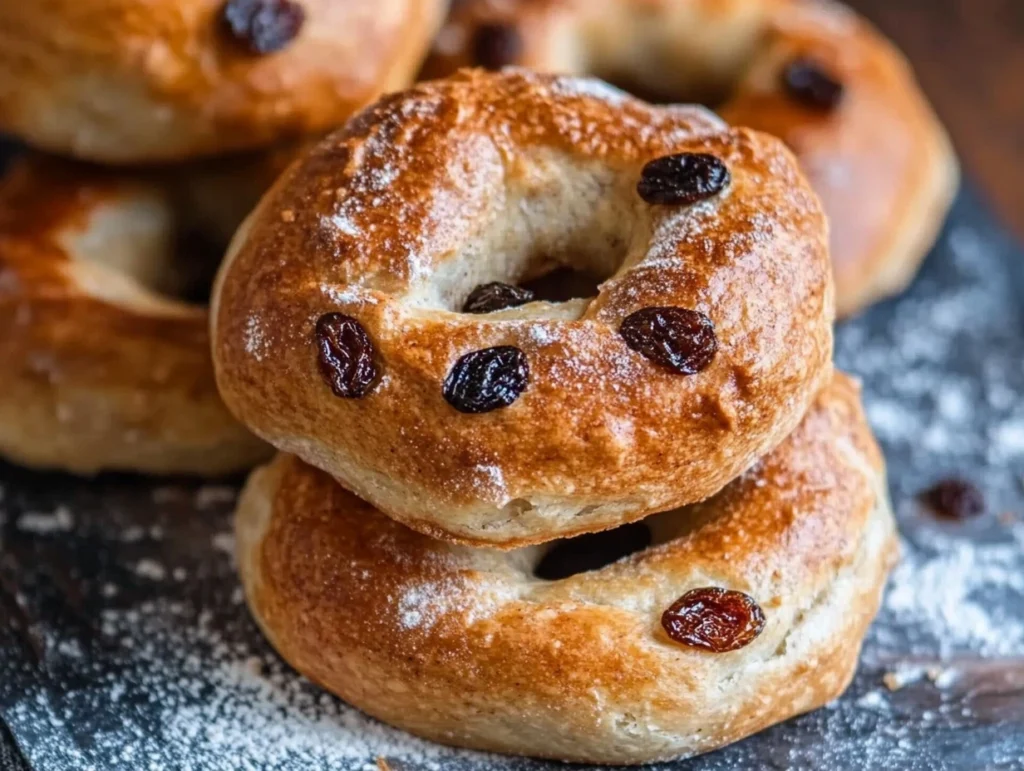There’s something irresistibly satisfying about sinking your teeth into a freshly baked bagel, especially one infused with the warm, spicy sweetness of cinnamon and the chewy pops of juicy raisins. Homemade cinnamon raisin bagels offer the perfect combination of flavor, texture, and freshness that store-bought options simply can’t match. Baking bagels at home not only allows you to enjoy a comforting treat but also gives you the freedom to experiment with flavors and customize your creation to suit your taste. Plus, it’s a rewarding process that brings the delightful aroma of a bakery right into your kitchen.
Table of Contents
What Are Bagels?
Bagels are round, doughy bread products with a hole in the center, known for their dense yet chewy texture and slightly crispy crust. Originating from Eastern Europe, bagels have a rich history that dates back to the 17th century, when they became a staple among Jewish communities in Poland. Their distinct texture is achieved through a unique preparation process involving boiling the dough before baking it. Over time, bagels gained popularity across the world, evolving into a versatile food enjoyed plain, topped with seeds, or flavored with ingredients like cinnamon and raisins.
Why Make Bagels at Home?
Making bagels at home is a delightful experience that goes beyond just enjoying a delicious end product. From the cost savings to the ability to tailor each batch to your liking, there are many reasons to embrace the art of homemade bagel-making.

Cost-Effectiveness
One of the most compelling reasons to make bagels at home is the cost savings. While a single bagel from a bakery or café can add up quickly, especially if you’re a regular bagel enthusiast, the ingredients for homemade bagels—flour, yeast, sugar, and other staples—are inexpensive and yield a larger quantity. You can easily create a dozen bagels at home for the price of just a few store-bought ones, making it a budget-friendly option for families or those who enjoy batch cooking.
Customization
Homemade bagels provide the ultimate opportunity to customize your breakfast or snack. Whether you prefer a more cinnamon-forward flavor or want to experiment with additional mix-ins like nuts, chocolate chips, or even different dried fruits, the possibilities are endless. You can also adjust the size and density of the bagels to your liking, ensuring that every bite is exactly how you want it. This level of personalization simply isn’t possible with prepackaged or bakery bagels.
Making cinnamon raisin bagels at home is more than just cooking—it’s about creating an experience filled with aroma, warmth, and a personal touch that turns a simple baked good into something extraordinary.
Ingredients Needed
To create the perfect batch of homemade cinnamon raisin bagels, you’ll need a handful of essential ingredients, each playing a crucial role in achieving the right flavor, texture, and rise. Here’s a full breakdown of what you’ll need and why these ingredients matter.
- Flour: The foundation of your bagels, providing structure and chewiness.
- Yeast: The rising agent responsible for the bagels’ airy, chewy interior.
- Sugar or Honey: Adds sweetness to the dough and feeds the yeast for proper fermentation.
- Cinnamon: The star spice that gives these bagels their warm, aromatic flavor.
- Raisins: Adds bursts of sweetness and texture throughout the bagels.
- Salt: Enhances flavor and strengthens the dough structure.
- Water: Essential for hydrating the dough and creating the right consistency.
- Optional Toppings: Like a cinnamon-sugar mixture, for a sweet, crunchy crust.
Flour Selection
The type of flour you choose significantly impacts the texture of your bagels. Bread flour is the most common choice because of its high protein content, which promotes gluten development. Gluten is what gives bagels their characteristic chewiness and structure. If you prefer softer bagels, you can use all-purpose flour, but they may lack the same chewy texture. Experimenting with whole wheat or other specialty flours can also yield unique flavors and nutritional benefits.
Yeast and Rising Agents
Yeast is the key ingredient that allows your bagels to rise, creating an airy interior. Active dry yeast or instant yeast both work well, but each requires slightly different handling. Active dry yeast needs to be proofed in warm water with sugar to activate, while instant yeast can be added directly to the flour.
Proper handling of yeast is crucial—water that’s too hot can kill it, while water that’s too cold may not activate it. The ideal water temperature is around 105–110°F (40–43°C). Patience is also important, as allowing the dough to rise for the right amount of time ensures your bagels will have the perfect texture and flavor.
Cinnamon and Raisins
Cinnamon and raisins are what make this bagel variety so special. Cinnamon adds a warm, spicy aroma and flavor, elevating the overall taste. It’s best to use high-quality ground cinnamon for maximum flavor impact.
Raisins add natural sweetness and a chewy texture that complements the dense bagel dough. To prevent them from drying out during baking, you can soak the raisins in warm water for about 10 minutes before mixing them into the dough. This step also ensures an even distribution of raisins throughout the bagels, so every bite is flavorful.
Equipment You’ll Need
To create homemade cinnamon raisin bagels, having the right tools on hand is just as important as the ingredients. These essential tools will make the process smoother and help you achieve bakery-quality results.
Mixing Tools
- Mixing Bowls: A set of large bowls for combining and proofing the dough. Look for bowls that are roomy enough to allow the dough to rise.
- Wooden Spoon or Spatula: Useful for mixing the initial ingredients before kneading.
- Stand Mixer (Optional): While not essential, a stand mixer with a dough hook attachment can save time and effort, especially if you’re making a large batch.
- Measuring Cups and Spoons: For precise measurements of flour, water, and spices.
Baking Tools
- Baking Sheets: A sturdy baking sheet lined with parchment paper or a silicone baking mat to prevent sticking and ensure even baking.
- Oven Thermometer: To confirm your oven is at the correct temperature for perfectly baked bagels.
- Pot for Boiling: A large, wide pot for boiling the bagels before baking. Stainless steel or enamel-coated pots work well.
- Slotted Spoon or Spider Strainer: For removing the boiled bagels from the water without damaging their shape.
Step-by-Step Recipe
Preparing the Dough
- Combine Dry Ingredients: In a large bowl, mix together bread flour, cinnamon, salt, and sugar. Stir until evenly distributed.
- Activate the Yeast: If using active dry yeast, dissolve it in warm water (105–110°F) with a pinch of sugar and let it sit for 5–10 minutes until foamy. If using instant yeast, you can skip this step and add it directly to the flour mixture.
- Mix the Dough: Gradually add the water (and yeast mixture, if applicable) to the dry ingredients. Stir with a spoon or mix using a stand mixer with a dough hook. Add the raisins during this step, ensuring they are evenly distributed.
- Knead: Knead the dough for about 8–10 minutes by hand or 5–7 minutes in a stand mixer until it is smooth, elastic, and slightly tacky.
- First Rise: Place the dough in a lightly oiled bowl, cover it with a damp towel or plastic wrap, and let it rise in a warm spot for about 1–1.5 hours, or until it doubles in size.
Shaping the Bagels
- Divide the Dough: Punch down the dough and divide it into equal portions (typically 8–12 pieces, depending on your preferred bagel size).
- Form the Bagels: Roll each portion into a ball, then use your thumb to poke a hole through the center. Gently stretch the hole to about 1–2 inches in diameter. Remember, the hole will shrink slightly during boiling and baking.
- Second Rise: Place the shaped bagels on a parchment-lined baking sheet, cover lightly, and let them rest for 15–20 minutes.
Boiling the Bagels
- Prepare the Water: Fill a large pot with water and bring it to a gentle boil. Add a tablespoon of sugar or honey to the water to enhance the crust’s shine and flavor.
- Boil the Bagels: Carefully drop the bagels into the boiling water, 2–3 at a time, ensuring they have enough space to float freely. Boil each side for 30–60 seconds (longer boiling results in chewier bagels).
- Drain: Use a slotted spoon or spider strainer to remove the bagels from the water, letting the excess water drip off before placing them back on the baking sheet.
Baking to Perfection
- Preheat the Oven: Set the oven to 425°F (220°C) and ensure it’s fully preheated before baking.
- Optional Toppings: If desired, sprinkle the bagels with a cinnamon-sugar mixture before baking for extra flavor and crunch.
- Bake: Place the bagels in the oven and bake for 18–22 minutes, or until golden brown. Rotate the baking sheet halfway through for even baking.
- Cool: Transfer the bagels to a wire rack and allow them to cool for at least 10 minutes before serving.

Troubleshooting Common Issues
Homemade bagels are a rewarding project, but sometimes issues can arise during the process. Here are some common problems and how to solve them to ensure your cinnamon raisin bagels turn out perfectly every time.
Dough Not Rising
Causes:
- Yeast was not properly activated (e.g., water was too hot or too cold).
- Expired or inactive yeast.
- The dough was left in a spot that’s too cold.
Solutions:
- Always check the expiration date on your yeast and proof it in warm water (105–110°F) to ensure it’s active. Look for bubbles or foam as a sign that the yeast is alive.
- Let the dough rise in a warm, draft-free area. If your kitchen is cold, place the dough in an oven with the light turned on or near a warm appliance.
- Avoid killing the yeast by ensuring the water isn’t too hot. Use a thermometer to check the temperature.
Uneven Texture
Causes:
- Inconsistent kneading led to uneven gluten development.
- The bagels weren’t boiled long enough or evenly.
- Improper shaping caused uneven cooking.
Solutions:
- Knead the dough thoroughly until it’s smooth and elastic to ensure even gluten development.
- When boiling, make sure each bagel spends an equal amount of time on each side (30–60 seconds per side).
- Shape the bagels evenly, ensuring the hole in the center is big enough so it doesn’t close during baking.
Tips for Storing Bagels
Freshly baked bagels taste best on the day they’re made, but proper storage can help you enjoy them longer.
Freezing Bagels
- How to Freeze: Let the bagels cool completely after baking. Place them in an airtight bag or container, separating each bagel with parchment paper to prevent sticking.
- Reheating: When ready to enjoy, thaw the bagels at room temperature, then reheat in a toaster or oven at 375°F (190°C) for 5–10 minutes. This restores their crispy crust and chewy texture.
Storing at Room Temperature
- If you plan to eat the bagels within a day or two, store them in a paper bag or a breadbox at room temperature. Avoid plastic bags, as they trap moisture and can make the crust soggy.
Serving Suggestions
Cinnamon raisin bagels are versatile and can be enjoyed in a variety of ways, whether as part of a hearty breakfast or a quick snack.
Breakfast Ideas
- Classic Spread: Smear with cream cheese or butter for a simple and satisfying start to the day.
- Sweet Toppings: Add a drizzle of honey, a sprinkle of cinnamon sugar, or a dollop of jam for an extra burst of sweetness.
- Savory Twist: Balance the sweetness with a touch of whipped goat cheese and a few sliced strawberries. Pair with a hot cup of coffee or tea for a perfect morning treat.
Snack Pairings
- Mid-Day Energy Boost: Pair a toasted cinnamon raisin bagel with peanut butter and banana slices for a filling, protein-packed snack.
- Creative Combos: Try spreading mascarpone cheese and topping with a handful of toasted almonds or granola for added crunch.
- On-the-Go Option: Pack a bagel with a small container of Nutella or almond butter for a portable treat.

Health Benefits of Cinnamon Raisin Bagels
Cinnamon raisin bagels aren’t just a delicious treat—they also provide some surprising nutritional benefits, thanks to their key ingredients. Here’s a closer look at how cinnamon and raisins contribute to both flavor and wellness.
Benefits of Cinnamon
Cinnamon is not only a beloved spice for its warm and comforting flavor, but it also offers impressive health benefits:
- Antioxidant Properties: Cinnamon is packed with powerful antioxidants, such as polyphenols, which help combat free radicals in the body, reducing oxidative stress.
- Anti-Inflammatory Effects: Certain compounds in cinnamon, like cinnamaldehyde, are known to reduce inflammation, potentially lowering the risk of chronic diseases.
- Blood Sugar Regulation: Cinnamon has been shown to improve insulin sensitivity and help regulate blood sugar levels, making it a great addition to your diet when consumed in moderation.
Nutritional Value of Raisins
Raisins add natural sweetness and texture to your bagels while also offering nutritional perks:
- Energy Boost: Raisins are a great source of natural sugars like fructose and glucose, providing a quick energy boost without added processed sugars.
- Rich in Fiber: With their high fiber content, raisins can help support digestion and promote a feeling of fullness.
- Packed with Micronutrients: Raisins contain essential minerals like iron, potassium, and magnesium, which are important for maintaining healthy blood flow, muscle function, and overall energy levels.
FAQs
1. Why do I need to boil bagels before baking?
Boiling is a critical step in the bagel-making process as it sets the crust, giving bagels their signature chewy texture. It also helps create the shiny, golden exterior during baking.
2. Can I use whole wheat flour instead of bread flour?
Yes, but the texture will be slightly denser. Whole wheat flour adds more fiber and nutrients but lacks the high gluten content of bread flour, which contributes to the chewiness of traditional bagels. For the best results, consider using a blend of whole wheat and bread flour.
3. How do I prevent my raisins from burning in the oven?
To keep raisins from burning, make sure they’re evenly mixed into the dough, rather than sitting on the surface. Soaking raisins in warm water before adding them to the dough can also help keep them moist during baking.
4. How can I make my bagels less dense?
Ensure that your yeast is active, and give the dough enough time to rise properly. Kneading the dough thoroughly to develop gluten is also key to creating a light, chewy interior.
5. Can I make bagels without a stand mixer?
Absolutely! Bagels have been made by hand for centuries. Kneading by hand may take a bit more effort but works just as well. It’s also a great way to connect with the dough and ensure its texture is just right.
While describing the health benefits of raisins, you can link to the article on Oatmeal Applesauce Pancakes Recipe, which also highlights nutrient-packed ingredients for a hearty breakfast.
When discussing breakfast pairings, mention and link to the Peanut Butter Granola Clusters Recipes, providing readers with complementary recipes to enjoy alongside bagels.
Under the topic of sweet toppings, you could reference the Strawberry Sauce for Cheesecake as an alternative spread to elevate the bagels’ flavor profile.
For readers interested in learning more about baked goods, you might link to Almond Croissants when discussing other baked breakfast treats to try.
To cater to those looking for customization options, suggest exploring the Lemon Blueberry Granola Clusters Recipes for inspiration in experimenting with flavors.
Conclusion
Making homemade cinnamon raisin bagels is a rewarding experience that combines the joy of baking with the satisfaction of creating a delicious treat tailored to your taste. From selecting the perfect ingredients to mastering the art of boiling and baking, every step of the process contributes to the unique flavor and texture of these classic bagels. Along the way, you’ll enjoy the delightful aroma of fresh cinnamon and discover the many ways to serve and store your creations.
Whether you’re motivated by the cost-effectiveness, the ability to customize, or the health benefits of homemade baking, these bagels are sure to become a favorite in your kitchen. With the tips and insights shared here, you’re ready to create bakery-quality cinnamon raisin bagels that are as enjoyable to make as they are to eat.

